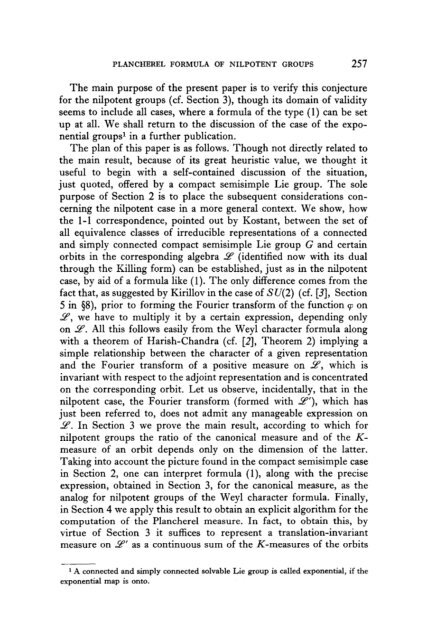On the Characters and the Plancherel Formula of Nilpotent Groups ...
On the Characters and the Plancherel Formula of Nilpotent Groups ...
On the Characters and the Plancherel Formula of Nilpotent Groups ...
You also want an ePaper? Increase the reach of your titles
YUMPU automatically turns print PDFs into web optimized ePapers that Google loves.
PLANCHEREL FORMULA OF NILPOTENT GROUPS 257<br />
The main purpose <strong>of</strong> <strong>the</strong> present paper is to verify this conjecture<br />
for <strong>the</strong> nilpotent groups (cf. Section 3), though its domain <strong>of</strong> validity<br />
seems to include all cases, where a formula <strong>of</strong> <strong>the</strong> type (1) can be set<br />
up at all. We shall return to <strong>the</strong> discussion <strong>of</strong> <strong>the</strong> case <strong>of</strong> <strong>the</strong> expo-<br />
nential groups1 in a fur<strong>the</strong>r publication.<br />
The plan <strong>of</strong> this paper is as follows. Though not directly related to<br />
<strong>the</strong> main result, because <strong>of</strong> its great heuristic value, we thought it<br />
useful to begin with a self-contained discussion <strong>of</strong> <strong>the</strong> situation,<br />
just quoted, <strong>of</strong>fered by a compact semisimple Lie group. The sole<br />
purpose <strong>of</strong> Section 2 is to place <strong>the</strong> subsequent considerations con-<br />
cerning <strong>the</strong> nilpotent case in a more general context. We show, how<br />
<strong>the</strong> l-l correspondence, pointed out by Kostant, between <strong>the</strong> set <strong>of</strong><br />
all equivalence classes <strong>of</strong> irreducible representations <strong>of</strong> a connected<br />
<strong>and</strong> simply connected compact semisimple Lie group G <strong>and</strong> certain<br />
orbits in <strong>the</strong> corresponding algebra 9 (identified now with its dual<br />
through <strong>the</strong> Killing form) can be established, just as in <strong>the</strong> nilpotent<br />
case, by aid <strong>of</strong> a formula like (1). The only difference comes from <strong>the</strong><br />
fact that, as suggested by Kirillov in <strong>the</strong> case <strong>of</strong> SU(2) (cf. [3], Section<br />
5 in $S), prior to forming <strong>the</strong> Fourier transform <strong>of</strong> <strong>the</strong> function v on<br />
9, we have to multiply it by a certain expression, depending only<br />
on $4. All this follows easily from <strong>the</strong> Weyl character formula along<br />
with a <strong>the</strong>orem <strong>of</strong> Harish-Ch<strong>and</strong>ra (cf. [2], Theorem 2) implying a<br />
simple relationship between <strong>the</strong> character <strong>of</strong> a given representation<br />
<strong>and</strong> <strong>the</strong> Fourier transform <strong>of</strong> a positive measure on 9, which is<br />
invariant with respect to <strong>the</strong> adjoint representation <strong>and</strong> is concentrated<br />
on <strong>the</strong> corresponding orbit. Let us observe, incidentally, that in <strong>the</strong><br />
nilpotent case, <strong>the</strong> Fourier transform (formed with 9’), which has<br />
just been referred to, does not admit any manageable expression on<br />
9. In Section 3 we prove <strong>the</strong> main result, according to which for<br />
niipotent groups <strong>the</strong> ratio <strong>of</strong> <strong>the</strong> canonical measure <strong>and</strong> <strong>of</strong> <strong>the</strong> K-<br />
measure <strong>of</strong> an orbit depends only on <strong>the</strong> dimension <strong>of</strong> <strong>the</strong> latter.<br />
Taking into account <strong>the</strong> picture found in <strong>the</strong> compact semisimple case<br />
in Section 2, one can interpret formula (l), along with <strong>the</strong> precise<br />
expression, obtained in Section 3, for <strong>the</strong> canonical measure, as <strong>the</strong><br />
analog for nilpotent groups <strong>of</strong> <strong>the</strong> Weyl character formula. Finally,<br />
in Section 4 we apply this result to obtain an explicit algorithm for <strong>the</strong><br />
computation <strong>of</strong> <strong>the</strong> <strong>Plancherel</strong> measure. In fact, to obtain this, by<br />
virtue <strong>of</strong> Section 3 it suffices to represent a translation-invariant<br />
measure on 2’ as a continuous sum <strong>of</strong> <strong>the</strong> K-measures <strong>of</strong> <strong>the</strong> orbits<br />
1 A connected <strong>and</strong> simply connected solvable Lie group is called exponential, if <strong>the</strong><br />
exponential map is onto.

















